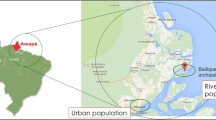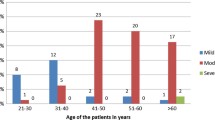Abstract
Introduction and hypothesis
Low socioeconomic factors may influence the development of stress urinary incontinence (SUI). Thus far, there is little research available on SUI in developing countries. We aimed to determine whether the prevalence of SUI in a northeastern Brazilian municipality was higher or lower than in the general female population.
Methods
Cross-sectional household cluster study of 1,180 climacteric women in the São Luís municipality (Maranhão state, Brazil) was conducted using a standardized questionnaire that was previously tested in a pilot study and administered by interviewers to obtain socioeconomic and cultural information, climacteric aspects, and life habits related to SUI.
Results
From this population, 15.34% (n = 181) had SUI; this prevalence did not change with age. More than half (57.92%) of the patients replied that they had not consulted a physician for their SUI. The presence of SUI was not associated with any socioeconomic or gynecological variables after multivariate analysis.
Conclusions
The prevalence of SUI in São Luís was similar to the rates observed in the general global female population. Socioeconomic and gynecological variables were not associated with SUI.

Similar content being viewed by others
References
Riss P, Kargi J (2010) Quality of life and urinary incontinence in women. Maturitas Dec 30 [Epub ahead of print]
Menezes M, Pereira M, Hextall A (2010) Predictors of female urinary incontinence at midlife and beyond. Maturitas 65:165–171
Lee J, Dwyer PL (2010) Age-related trends in female stress urinary incontinence surgery in Australia – Medicare data for 1994-2009. Aust N Z J Obstet Gynaecol 50(6):543–549
Zhu L, Lang J, Liu C, Han S, Huang J, Xingming L (2010) The epidemiological study of women with urinary incontinence and risk factors for stress urinary incontinence in China. Menopause 16(4):831–836
Biri A, Durukan E, Maral I, Korucuoglu U, Biri H, Tyras B et al (2006) Incidence of stress urinary incontinence among women in Turkey. Int Urogynecol J 17:604–610
Liapis A, Bakas P, Liapi S, Sioutis D, Creatsas G (2010) Epidemiology of female urinary incontinence in the Greek population: EURIG study. Int Urogynecol J 21:217–222
Ahmadi B, Alimohammadian M, Golestan B, Mahjubi B, Janani L, Mirzaei R (2010) The hidden epidemic of urinary incontinence in women: a population-based study with emphasis on preventive strategies. Int Urogynecol J 21:453–459
Alvaro R, Araco F, Gravante G, Sorge R, Overton J, Vellone E et al (2010) Epidemiological aspects of urinary incontinence in a female population of an Italian region. Int Urogynecol J 21:873–883
Guarisi T, Pinto-Neto AM, Osis MJ, Pedro AO, Paiva LH, Faundes A (2001) Urinary incontinence among climacteric Brazilian women: household survey. Rev Saude Publica 35(5):428–435
de Souza Santos CR, Santos VL (2010) Prevalence of urinary incontinence in a random sample of the urban population of Pouso Alegre, Minas Gerais, Brazil. Rev Lat Am Enfermagem 18(5):903–910
Tamanini JT, Lebrão ML, Duarte YA, Santos JL, Laurenti R (2009) Analysis of the prevalence of and factors associated with urinary incontinence among elderly people in the Municipality of São Paulo, Brazil: SABE Study (Health, Wellbeing and Aging). Cad Saude Publica 25(8):1756–1762
Jaszmann L (1973) Epidemiology of climacteric and post-climacteric complaints. In: Van Keep PA, Lauritzen C (eds) Ageing and estrogens 3rd ed. Front Hormone Res 2:22–34
Hannestad YS, Rortveit G, Sandvik H, Hunskaar S (2000) A community based epidemiological survey of female urinary incontinence: the Norwegian EPINCONT study. J Clin Epidemiol 53:1150–1157
Zhu L, Lang J, Liu C, Xu T, Liu X, Li L et al (2010) Epidemiological study of urge urinary incontinence and risk factors in China. Int Urogynecol J 21:589–593
Jahanlu D, Hunskaar S (2010) The Hordaland women’s cohort: prevalence, incidence and remission of urinary incontinence in middle-aged women. Int Urogynecol J 21:1223–1229
Hunskaar S, Lose G, Sykes D, Voss S (2004) The prevalence of urinary incontinence in women in four European countries. BJU Int 93:324–330
Berlezi EM, Dal Bem A, Antonello C, Leite MT, Bertolo EM (2009) Women urinary incontinence in post-menopause lifetime: a public health problem. Braz J Geriatr Gerontol 12(2):159–173
United Nations Development Programme (2010) Human development report 20th Anniversary Edition. Palgrave Macmillan 227p
Kubik K, Blackwell L, Heit M (2004) Does socioeconomic status explain racial differences in urinary incontinence knowledge? Am J Obstet Gynecol 191(1):188–193
Li Y, Cai X, Glance LG, Mukamei DB (2007) Gender differences in healthcare-seeking behavior for urinary incontinence and the impact of socioeconomic status: a study of the Medicare managed care population. Med Care 45(11):1116–1122
Rios AA, Cardoso JR, Rodrigues MA, Almeida SH (2011) The help-seeking by women with urinary incontinence in Brazil. Int Urogynecol J [Epub ahead of print]
Mishra GD, Cardozo L, Kuh D (2010) Menopausal transition and the risk of urinary incontinence: results from a British prospective cohort. BJU Int 106(8):1170–1175
Tsai YC, Liu CH (2009) Urinary incontinence among Taiwanese women: an outpatient study of prevalence, comorbidity, risk factors, and quality of life. Int Urol Nephrol 41(4):795–803
Waetien LE, Johnson WO, Xing G, Feng WY, Greendale GA (2011) Serum estradiol levels are not associated with urinary incontinence in midlife women transitioning through menopause. Menopause Jul 16 [Epub ahead of print]
Goldberg RP, Abramov Y, Botros S, Miller JJ, Gandhi S, Nickolov A et al (2005) Delivery mode is a major environmental determinat of stress urinary incontinence: results of the Evanston-Northwestern Twin Sisters Study. Am J Obstet Gynecol 193(6):2149–2153
Silva AA, Bettiol H, Barbieri MA, Pereira MM, Brito LG, Ribeiro VS et al (2005) Why are the low birthweight rates in Brazil higher in richer than in poorer municipalities? Exploring the epidemiological paradox of low birthweight. Paediatr Perinat Epidemiol 19(1):43–49
Walker GJ, Gunasekera P (2011) Pelvic organ prolapse and incontinence in developing countries: review of prevalence and risk factors. Int Urogynecol J 22(2):127–135
Conflicts of interest
None.
Financial support
Fundação de Amparo à Pesquisa do Estado do Maranhão (FAPEMA) and the National Council of Scientific and Technological Development (CNPq)
Author information
Authors and Affiliations
Corresponding author
Rights and permissions
About this article
Cite this article
Brito, L.G.O., Brito, L.M.O., Chein, M.B.d.C. et al. Stress urinary incontinence in climacteric women in a northeastern Brazilian municipality: a household survey. Int Urogynecol J 23, 639–645 (2012). https://doi.org/10.1007/s00192-012-1697-z
Received:
Accepted:
Published:
Issue Date:
DOI: https://doi.org/10.1007/s00192-012-1697-z




